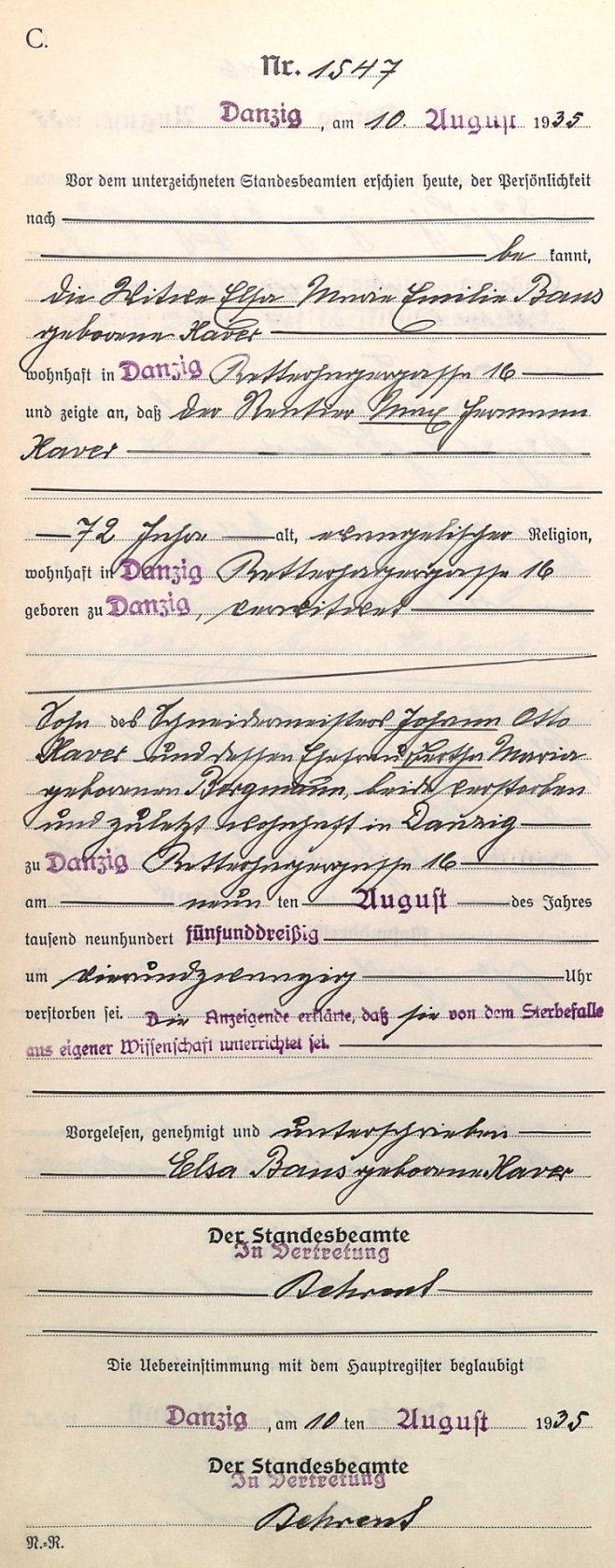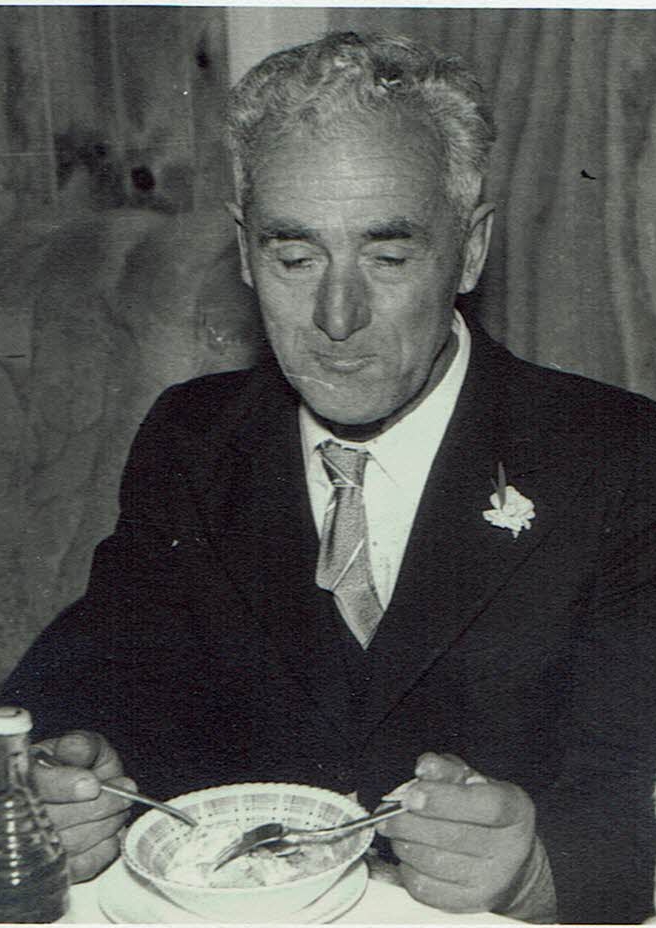
My grandfather died in 1978 in New Plymouth, New Zealand. We had visited my grandparents regularly and the things a small boy found fascinating were Frank’s delicious desserts (he was the cook) and not-so-nice dinners, boiled mince featuring prominently. Frank hardly ever spoke, to anyone, but I heard him once or twice singing lieder rather well. He listened to the BBC News every morning, and loved to swat flies with a yellowed plastic swatter embedded with pulverised fly residue. He didn’t hold back, the idea of just hitting the fly enough but not too much going unappreciated. I liked to copy him. My mother thought it was incredibly unhygienic, which added to the enjoyment.
He tended to ignore me pretty much and I was somewhat frightened of him, perhaps after I got a clip round the ear for putting the car window down and leaving him in a draught. He and more so my grandmother Rita liked to play cards with us, and Frank was quite keen on fishing too. Our favourite fishing spot was at Round Rock down-slope of the Dow chemical plant (simpler times, eh?). Frank swam at their suburb Fitzroy’s beach every day, summer and winter. The newspaper published a story about his daily swims along with a photo. Frank and Rita had retired to town off a small farm, and they kept lots of chooks in Fitzroy way before they were a trendy urban accessory. Their chook house and huge vege garden of black volcanic soil are now replaced by an infill house.
Frank only claimed the old-age pension long after he passed for 65 on looks alone, not having a birth certificate, and then only after Rita nagged him as they needed the money. He didn’t talk about his background, but Dad remembers him being born in Australia. The birth certificate was said to have been lost in a fire in Brisbane a very long time ago. He had a sister Elsa in Germany (my aunt’s middle name is Elsa). My uncle said recently that she had married a German wool buyer called Baus and gone to Germany to live with him. My mother among others was always suspicious of the back story, and there were suggestions stemming from the late uptake of the pension that he might have something to hide, like having jumped ship to arrive in New Zealand, or even- gasp- being German himself.
Over the years, the mystery about Frank’s background simmered along amongst the family. My uncle and aunt visited Elsa and some of her descendants in Germany, and a convincing story about Frank was not forthcoming, questions indeed being met with reticence. Elsa had said though that she was about 10 when Frank was born in Australia. Elsa evidently showed my aunt some identity papers or a passport and she was quite proud to point out that she had been born in Yorkshire, within coo-ee of where my aunt came from. Auntie recalled much later that Elsa’s maiden name seemed to be shown as Dent on the document.
Frank and Rita’s 1936 marriage certificate lists Frank’s birthplace as Brisbane, age at marriage 40, his father as Claude Dent, printer, and his mother as Violet, née Wilson. About two years ago I had a look around, and there were indeed one or more Frank Dents in Australia and a few in New Zealand. There were Claude Dents and Violet Wilsons, just not married to one another so far as I could find. In Australia a Frank Dent served in the first war and was about the right age. One sank his boat. A Claude Dent lived in a cave with cats for company. A Frank Dent, 38, born England, arrived in Wellington from Sydney on the Monowai on 4 March 1935.
There it sat, until I had time for a proper investigation. My interest brought forth from my sister a box of photos, postcards, a diary of sorts, job references, electoral enrolment cards and a letter fragment. My sister had done some investigation on the contents about 15 years ago. The postcards were from Frank’s sister Elsa Baus and her children and their spouses, and nearly all were in German. The material had come from my grandmother Rita, who gathered them up after Frank died and gave them to my mother. Rita could not read German and Frank always refused to translate them for her (assuming he could read German himself). My sister had had ten of the postcards and photo inscriptions translated, but had not really formed an opinion by the time work and family began to monopolise her time. Our aunt and uncle got copies but did not get anywhere either.

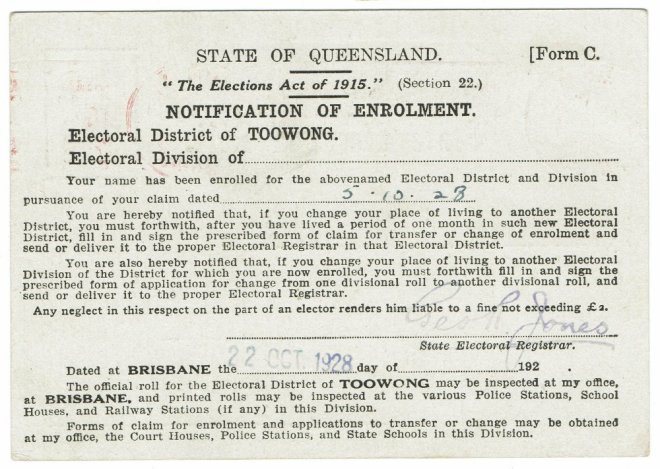
The earliest electoral enrolment card in the box, pictured, was dated 22 October 1928 in Toowong, a suburb of Brisbane. The six cards were from various places in Queensland and New South Wales, and the latest was dated 29 August 1933 in South Sydney. There was also a collection of favourable references from employers. Frank evidently worked as a cook in hotels and on stations up and down the eastern side of the country. The latest reference was dated 30 January 1935 in Warburton, Victoria.
Frank was working in New Zealand from March 1935, as evidenced by a reference from the Settlers Hotel in Whangarei. This ties up with the correct Frank Dent arriving on the Monowai in March 1935. He also worked in the Federal Hotel, Picton, as a labourer, in a foundry and in a dairy factory prior to, or in the early days of, taking up farming in Stratford.
Back to the cards and photos: Elsa Baus had a very neat hand, and in the modern style. In contrast, the Kurrentschrift in other hands on the back of some of the other photos is very beautiful, but very incomprehensible to me at least. I must say that having glanced at the contents of the box I thought it was pretty likely that Frank and his family were from Danzig. Relatives probably did not want to consider this seriously as they had been first-hand recipients of other stories. Of course it was possible that the family were ethnically Prussian, travelled to Australia for a prolonged period, then went back to Danzig, leaving Frank behind as he had been born there. However, I could not find any transit records for a family called Dent or anything similar. Working on the idea that the simplest story is always likely to be the correct one, I set to work on the photos and postcards.


It was quite easy to reconstruct Elsa Baus’ immediate family, especially as several of the photos had been annotated on the back. Elsa identified herself in several photos, and once also “Erich”, by inference her husband.
There are also some photos of people perhaps a generation further back, and some studio portraits taken by several firms in Danzig. I won’t speculate on them save for suggesting that the young woman in two of them might be Elsa:






Elsa and Erich’s children are in some of the photos also. The earlier one is annotated by Elsa and the later one by a daughter:


One other photo that really stood out was of an older couple, photographed at the seaside resort of Zoppot in 1929. Elsa (I think) had written on the back that it was the day Mother had a sore leg.

These folk are likely to be Frank’s parents also, but they are possibly not Claude Dent and Violet Wilson.
Let me put in some photos with a nautical theme now. None of them are annotated in any way except the first, which carries the imprint of a studio in Cuxhaven:


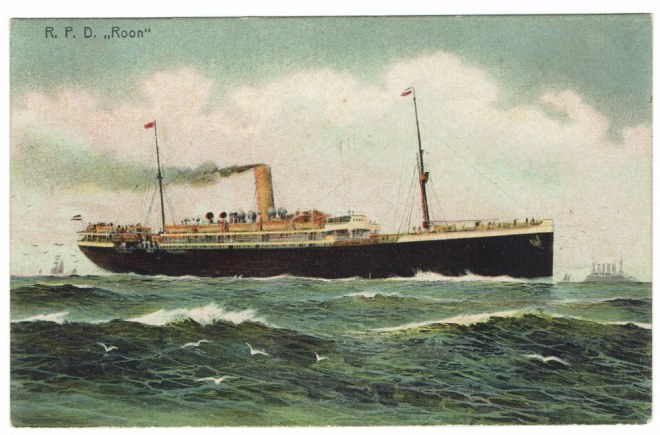
The photo in Cuxhaven is I think in front of a cloth backdrop. I’m going with a graduating contingent from the naval school. I can’t really pick Frank out in there, but the photo was in his possession. The next one is more interesting, but regrettably completely un-annotated. The man in naval uniform might well be Frank. Blowing the photo up shows the lettering on his cap as Kaiserl. Matr. Artillerie. Searching a few militaria sites (not my interest) shows that the man was an NCO in the Imperial Naval Artillery. Often the cap bands would say which ship the person was on, which would have been helpful, but the gunners could have been on any ship.
Given a birth date of about 1896 (from the age on his marriage certificate), this puts Frank (or his mates at least) in the Navy around the time of the first war. I couldn’t find any Frank Dents in the easily-searchable surviving records. Dent is of course a very uncommon surname in Germany and I considered it highly likely by this time that Frank Dent was born under another name.
Quickly to digress to the Roon: she was built in 1902 for Norddeutscher Lloyd and specialised in taking mail and steerage-class passengers to America and Australia. Many of the Australian passenger arrival records for the Roon exist, but there were no Frank Dents or similar on her. Moreover, her last voyage to Australia was in 1914, and she was two days out of Colombo headed for Fremantle when the captain received orders to head for the nearest neutral port in Java to avoid being captured. Eventually she was taken as war booty, sold to Greece after the war, and was scrapped in about 1925.
One working hypothesis was that Frank had emigrated to Australia after the war finished, perhaps in about 1923 after hyperinflation began and things became pretty dire in Germany. That wouldn’t have him on the Roon though. Another possibility is that he had served on the armoured cruiser S. M. S. Roon, and a non-naval person had sent him a mistaken memento in the form of a passenger steamer called the Roon. Whatever.
At this point, I really needed to know Elsa Baus’ maiden name, then I could make progress. My only option was to study the Baus family and see what might drop out. I wrote to the state archives in Gdansk, who did not promise a quick reply. To Ancestry and the Danzig address books!
Ancestry does not have a record for Elsa and Erich Baus’ wedding. I did not know where they were married or what religion they were (thinking ahead to looking in church records). The relaxed photo on the beach at Zoppot in 1942 ruled out their being Jewish, which was important information as the most prominent Baus family in Danzig was that of the Jewish owners of the respected iron and machine company Emil A Baus.
Ancestry has Erich Felix Carl Baus, Lutheran, born in Danzig on 15 March 1885 to Friedrich Hermann Baus and Lina Baus. Erich had a sister Anna, born in 1888 and an older brother, Ernst.
The Danzig address book for 1909 has father Hermann (but not his wife- she didn’t merit an entry according to the custom of the time), Erich and sister Anna at Korkenmachergasse 7. Hermann Baus owned a restaurant at that address. Could Frank have worked at the restaurant and his sister have met Erich through that connection? Could Frank have lived at the same address in a different apartment? The names in the reverse-lookup section for Korchenmachergasse 7 were Fuhrmann, Grabowski, Kerkchner, Kobielski and Misbach. Not really Dent.
Lina Baus got her own entry as Widow from 1915. Erich Baus had moved out to Wallplatz 7/8 by 1910, then to Ketterhagergasse 16 by 1915. He was at various times a magistrate’s assistant and some type of official, not a wool buyer.

Elsa Baus appears at Ketterhagergasse 16 as a Widow in 1937/8, along with daughter Liselotte. In 1942 they were still in Danzig. Son Günter was listed as a city inspector, which might explain why he was at the seaside in civilian clothes in Zoppot in 1942.
While looking at Ancestry and the address books, I searched for Dent and names like it. I got quite excited for a while by the Dentz clan in Ohra, near Danzig. Friedrich Dentz cropped up more than once, but there wasn’t one with a likely birth date, or any evident connection to family Baus.
The later postcards and photos are from further west than Danzig. Elsa and at least some of her family were in Plön by August 1945. They would have escaped Danzig either before the Russians arrived, or were expelled later. To generalise, ethnic Germans tended to be despised by the Polish minority in Danzig, and vice-versa. Many Poles were displaced from further east and took over the city abandoned by the Germans. There are accounts online of the dangerous journey to the west by the refugees, either by train or by ship.
A typical postcard from the box shows the family dispersing around western Germany:

This one is from Vallendar. Liselotte has written on the front of the postcard from Elsa to Frank, and Elsa has marked where Liselotte (Lilo) is living.
Liselotte was married to a long-established merchant of natural flavourings. Günter had a wife and daughter. Ellinor qualified as a pharmacist and there is a 1956 wedding invitation in the box- she married a fellow pharmacist.
At no point was Frank Dent referred to other than by that name or as “brother” or “uncle” as the case may be. Most of the postcards were un-stamped, presumably having been put into outer envelopes lest someone read German on them and jump to conclusions. The postcards were warm and friendly and carried on until the late 1960s. The only odd note was a paragraph from Ellinor after the end of the war, remarking that it was now a lovely place, needing only money and something to spend it on, but that that would be hard for Frank to understand as he would have wanted for nothing.
Frank and Rita sent food parcels, which they could ill-afford, to the family in Germany to assist them after the war. The evidence in the box is of a family that got on very well. Yet later there have been hints that family in Germany does not wish to discuss Frank. I tracked down a second cousin once removed recently, who mentioned that Frank was considered persona non grata. I haven’t had any elaboration on that at the time of writing this.
Two weeks before writing this I was running out of ideas on how to get anywhere, and even sent out a couple of highly speculative letters to pharmacies to try to find descendants of Ellinor. I also submitted for translation a dozen pages of the “diary” that was in the box, which had been glanced at by my sister’s translator and rated of low interest. This notebook or diary contained verse, some names and addresses (without likely surnames), an apparent diary of a 1908 trip around Germany that was related to an interest in opera, a type of leave-taking written in 1923 by someone with only initials as a signature, some recipes, and a record of rent paid in New Zealand. It was in German in English, and only a few pages were probably in Frank’s hand. It gave the impression very much of a random notebook with some useful blank pages in it that ended up with Frank Dent. I’ll report on this later if the translation can fill out the story.
I was not happy that what I thought was fairly diligent research hadn’t gone anywhere. A week later I was looking on You Tube for ideas and watched an expert on genealogy, talking about how to get beyond roadblocks. He mentioned that social media and special interest discussion groups were very valuable, which I hadn’t tried out of pathological aversion and monolingualism respectively. I got to within 30 minutes of signing up for Facebook, showing how desperate I was, but first I managed to get registered on forum.danzig.de.
I navigated to the archived discussions, and CTRL F’ed “Elsa Baus”. A single hit came up, of Elsa Baus, geb. Xaver, being listed as someone who had died in 1968. It turned out to be a listing of deaths recorded in Unser Danzig, 1968, Issue 23, a publication for Danzig expats. A Google search for Elsa Baus geb. Xaver shows that the page had been indexed, but it could have been anywhere in the 219,000 hits for Elsa Baus; it did not appear in a search for “Elsa Baus”.
I knew there was only one Elsa Baus in the Danzig address books, or at least only one who had had her own entry at some point, so figured this was her.
The following morning down at the library (gorse-filled pockets, you understand), I fired up Ancestry and found two Elsa Xavers in Danzig:
Elsa Emma Xaver was born on 4 June 1887 to Gustav and Emma Xaver. Gustav Xaver died in 1925 so could not have been photographed at Zoppot in 1929. In any case, Elsa Emma Xaver married Emil Arthur Hüppe.
Elsa Marie Emilie Xaver, however, was born on 5 March 1887 to Max Hermann Xaver and Emma Auguste Martha Xaver geb. Waldheuer. Max Xaver died in 1935. The Danzig address book for 1910 showed Max Xaver as owner of Ketterhagergasse 16, where Elsa and Erich Baus had subsequently lived. This was my great aunt Elsa. Unfortunately there were no records linking Max or Emma Xaver to a son. Max Xaver owned a book-printing business (Frank Dent’s marriage certificate has his father Claude Dent as a printer).
Now, what of the Australian connection? Ancestry and the National Archives in Canberra showed up several records for an E. or an Eric Xaver, and no others with the surname Xaver. An Eric Xaver was entered on a Record of Aliens as having been arrested in Tasmania in March 1916, after arrival from Melbourne with a permit to travel. He was released and returned to Melbourne.

An Eric Xaver had been on parole and failed to report to the Victoria police in February 1917. He was listed as age 26, slim, 5’6″ and with a dark complexion (my grandfather was always deeply tanned and about that height). He was an ex-“corporal” of the German navy. An E Xaver arrived in Sydney from Townsville on the Canberra on 9 April 1915.

An Eric Xaver had married Elsa Bialke in St Peters district, NSW in 1914. I promptly requested the certificate from NSW Births, Deaths and Marriages.
The last record I found was a December 1914 application from Eric Xaver for naturalisation. In it, he stated he had arrived in Sydney from Bremerhaven on the Roon on 17 November 1912. This is the steamer in the postcard. He was in Cairns at the time of application and had lived in seven other locations in NSW and Queensland since his arrival. He stated he was married and that his wife had returned to Germany. There were no children. In the accompanying statutory declaration, he said he was born in Stettin on 31 December 1889. Eric Xaver was informed in early 1915 that his application was not being proceeded with.


Ancestry did not show any such birth in Stettin. The Sydney disembarkation records for November 1912 for the Roon have escaped me online but it looks like the physical records can be viewed at NSW State Archives. She put off some passengers at Fremantle a fortnight earlier, but Eric Xaver was not listed there. Those that disembarked had to be certified by the Master and Medical Officer that to the best of their knowledge they were not, among other things, “idiots”. How did that work out, Australia?
The following day, the marriage certificate arrived, confirming that Eric Xaver’s parents were Elsa Baus’ parents Max Xaver and Emma Waldheuer. Eric Xaver was Frank Dent was Elsa Baus’ brother (or a very elaborate deception was playing out). I could not see any reason why lies would be told at that time, especially as he was playing it straight and trying to get naturalised.
The archives in Szczecin/Stettin are extensively digitised, but my Polish is non-existent, and I could not work out how to search them. Bearing in mind the brick-wall-shattering advice to seek special-interest groups, I registered on Pommern-L and posted a request. Within 49 minutes, Uli Hanke had sent me instructions with a link to the period of interest. Alicja Kościelna at the Archiwum Państwowe w Szczecinie kindly sent me the links the following day also, in reply to my email.
On 14 January 1890, the birth of Erich Max Rudolf Xaver on 31 December 1889 was registered in Stettin. This is the date of birth on Eric Xaver’s naturalisation application. The parents were Max Hermann Xaver and Emma Auguste Martha Xaver geb. Waldheuer.

I don’t know why the family had been in Stettin for Erich’s birth and I was keen to place the Australian Eric Xaver back in Danzig, especially since his wife Elsa Bialke was from Danzig also. She had arrived in Sydney on the Roon’s sister ship Gneisenau a week before she got married. Frank was allegedly a bit of a charmer in his day, but a week is quick. They would have been betrothed back in Danzig. He would have gone ahead and sent for her once established in Australia.
For some weeks I had been aware of the Archion project to digitise all of the German Evangelical (Lutheran) church’s records. Indeed I had first read about it in a blog by Katherine Schober in the USA, on the strength of which I had engaged her to translate pieces of the “diary”. I should have mentioned a 1950 newspaper clipping in the box which I had pondered. It was a picture of St Marienkirche in central Danzig. Elsa had sent it to Frank either because it was of significance or because it was something from the newspaper that day to fill up the envelope (if any photo of Danzig was to be in the paper it would be of that famous church). I had earlier thought I was very smart to have discovered that the Baus’ restaurant was a stone’s throw from the big church and that might be why Frank would be interested. But, as my payment to access the Archion site went through, I was itching to search the St Marienkirche records first. However, there were 24 Lutheran churches in central Danzig and 26 in nearby towns.
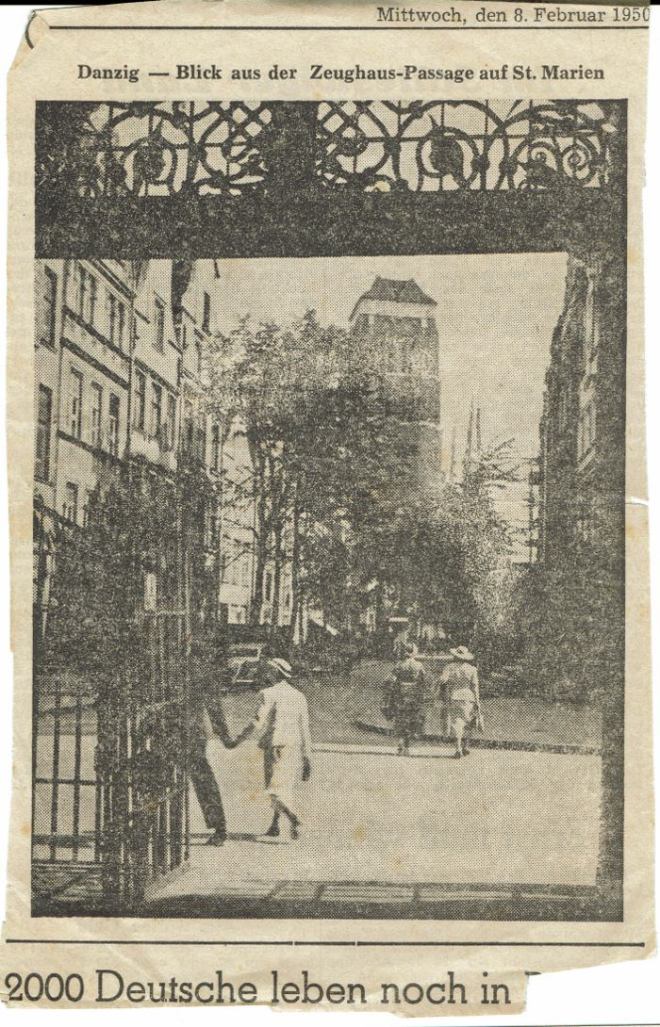
I started at the top of the list. The records in general contain indices to baptisms, marriages and burials. The indices are alphabetical by surname, compiled over however long it took to fill up that particular volume, and give references to the records themselves in other volumes. A family Xaver, possibly the family of the other Elsa Xaver, showed up at St Barbara’s, and there were no others until I got to St Marienkirche. Elsa’s baptism showed up first, a month after her birth, giving her parents’ names, and listing witnesses and so on. Erich Max Rudolf Xaver turned out to have been baptised in the same church, but not until 1892, two years or so after he was born. The reference number was not in the same form as for other baptisms, perhaps because the birth was out of town. The parents were not listed by name, except that the Witnesses column had “the parents of the child”. A note said that the parents had not been listed on the “Attest”. I take this to mean that an intermediate-type document in Danzig was short on detail, as opposed to the actual birth certificate in Stettin a fair distance to the west.



A bit more looking around in the same church showed up Erich Baus’ marriage to Elsa Xaver on 5 October 1908. Their daughter Liselotte was born on 26 November 1909 and baptised there. Witnesses to Liselotte’s baptism included Erich Baus’ sister Fraulein Anna Baus, Max Xaver, and Erich Xaver. Erich Xaver’s occupation was listed as “Geschützführer 7. Marine”. Katherine Schober’s translation is “gun captain/gunner/gun commander of the 7th navy” (I suspect it is the 7th Flotilla or some such). This matches up with the inscription on the sailor’s cap, and the history of the Eric Xaver who failed to report to the police in Australia.
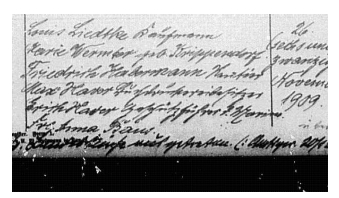
I have requested that the Bundesarchiv have a look for Erich Xaver in their naval records, and will report on this later if they find anything.
To complete research for the moment, I looked for Erich Xaver’s wife Elsa Bialke. Lucia Elsa Bialke was born in Danzig on 3 August 1893. She did get back to Danzig after marrying in Australia, and in 1923 under the name Lucia Elsa Xaver, geb. Bialke, married Karl Wilhelm Albert Meyer. They were divorced in 1938. I don’t think this was so that one or both of them might outrun the Nazis, as Meyer had been baptised in one of the Lutheran churches, at least as far as my peering at Kurrent goes.
Let me put in another photo: this one is annotated on the front in English; the handwriting is similar to, but possibly not the same as that of Elsa Baus. On the reverse, the 1913 message translates as “A little something to remember your dear old Danzig by. Much love, Elsa. Mama sends her love”. Is this a photo of Elsa Bialke and her mother?


Thinking on all of this, I find the early story of my Grandfather to be rather tragic. The rise of Prussian militarism from the 1870s led to compulsory military service. He either volunteered or was called up. Dad recalls Frank Dent as being very anti-war, as had been many young Prussian men at the start of the twentieth century. They were not allowed to emigrate unless they had completed their service after being called up at 20. Looking at the dates, Erich Xaver either volunteered at 18 (and so made NCO?) or got called up at 20 and left irregularly in order to be in Australia at the end of 1912. A steady trickle of young men began to leave through Hamburg and Bremerhaven and Erich was among them. A popular destination was Australia and he arrived there in 1912, his fiancée getting there at the end of April 1914. They were married in early May, and war between Britain and Germany was declared on 4 August.
Antipathy to the Germans in Australia ramped up to the point of hysteria. People were being thrown out of their jobs and worse for having German surnames. Many were interned as enemy aliens (for information about the situation in Australia refer to an article by Wayne Knoll, which even has an entry for Eric Xaver as it turns out). Perhaps Erich Xaver and Elsa Bialke thought that the war would be over by Christmas, as everyone initially did in Britain, and that she should wait it out in Danzig rather than be interned in Australia. Erich himself was possibly not welcome back as he had emigrated rather than stay to fight an upcoming pointless war.
Erich Xaver, wifeless, borderline stateless, sick of being picked up by the police and hounded out of jobs, I am going to say “went bush”, and eventually acquired the name Frank Dent. He gained legitimacy by getting on the electoral roll after a time, which with maybe a few other bits and pieces, like employer references, got him on the boat to New Zealand in 1935 for a fresh start.

Frank Dent and Elsa Baus continued the deception, even to closest family, until they died. The family in Germany was initially close but became distant towards Frank, to say the least, much later on. An early feeling that Erich might have been a “traitor” for emigrating in 1912 was not present in the box of material I have. If he committed bigamy, it was surely technical. Perhaps fear of deportation from New Zealand for having a false identity became so ingrained that the truth never was or needed to be told.
This article is written mainly so that family in New Zealand and Australia can see my reasoning, and absorb their new family history at leisure. I hope that general readers stumbling on it will find it interesting also. There is probably something else to this story and if anyone reading this can fill in the gaps, I will add to this article, or draw a discreet line under it, as appropriate. Any other pieces of research still outstanding will be worked into later edits of this article also.

 To wrap up this work I thought it might be nice for family and anyone else reading, to summarise what I can find out about Frank Dent/ Erich Xaver’s ancestors.
To wrap up this work I thought it might be nice for family and anyone else reading, to summarise what I can find out about Frank Dent/ Erich Xaver’s ancestors.
















